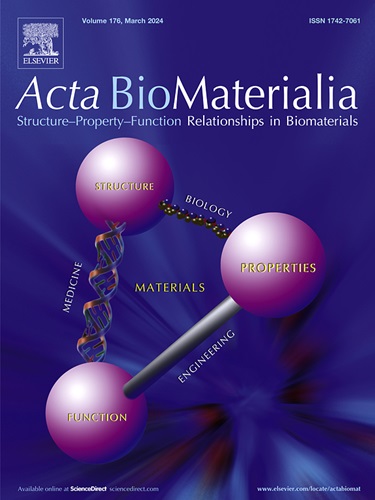Extracellular matrix ligands modulate the endothelial progenitor cell secretome for enhanced angiogenesis
IF 9.4
1区 医学
Q1 ENGINEERING, BIOMEDICAL
引用次数: 0
Abstract
Wound healing is a complex physiological process fundamentally dependent on angiogenesis for effective tissue repair. Endothelial progenitor cells (EPCs) have shown significant potential in promoting angiogenesis, primarily through their secretome, rich in proteins and extracellular vesicles (EVs) essential for cell signaling and tissue regeneration. This study investigates the effect of a collagen-bound proteoglycan mimetic (LXW7-DS-SILY or LDS), that binds to the αvβ3 integrin receptor, on the EPC secretome, with a dual focus on the proteomic content and the functional properties of EVs. Utilizing high-resolution two-dimensional liquid chromatography-tandem mass spectrometry (LC-MS/MS) alongside bioinformatic analysis, we identified significant alterations in protein expression profiles, particularly in angiogenesis and wound healing pathways. The functional impact of these changes was validated through biological assays, where the whole secretome and the EV fraction from EPCs seeded on collagen-bound LDS markedly enhanced vascular network formation, driven by the increase of growth factors and angiogenic regulators such as FGFR1, NRP1, and ANGPT2 within the EV fraction. Gene Ontology (GO) enrichment analysis further highlighted the enrichment of proteins within the EVs driving biological processes, including 'response to wounding' and 'positive regulation of cell motility'. These results underscore that LDS modulates the EPC secretome and significantly enhances its angiogenic potential, offering a promising therapeutic strategy for non-healing and ischemic wounds and suggesting that biomaterials can be modified to control the EV secretome to enhance tissue repair. Functional assays validating the omics data highlight the robustness of LDS as a targeted therapeutic for enhancing angiogenesis and tissue repair in clinical settings. Moreover, the pivotal role of EVs in mediating pro-angiogenic effects offers insights into developing biomaterial therapies that exploit key regulators within the EPC secretome for wound healing.
Statement of significance
This manuscript explores how a proteoglycan mimetic that binds to both collagen and the αvβ3 integrin receptor affects the proteome component of the secretome from endothelial progenitor cells (EPCs). It presents functional biological data, analytical data, and proteomic analysis of the soluble and extracellular vesical (EV) components of the secratome. The proteomic data maps to the observed enhanced angiogenic potential of the EVs. These results suggest that by controlling the cellular environment and judicially engineering how cells interact with a biomaterial can influence the proteomic composition of EVs to enhance tissue regeneration. This is the foundation of future work aimed at engineering biomaterial cell systems to influence the proteomic component of EVs for therapeutic use.

求助全文
约1分钟内获得全文
求助全文
来源期刊

Acta Biomaterialia
工程技术-材料科学:生物材料
CiteScore
16.80
自引率
3.10%
发文量
776
审稿时长
30 days
期刊介绍:
Acta Biomaterialia is a monthly peer-reviewed scientific journal published by Elsevier. The journal was established in January 2005. The editor-in-chief is W.R. Wagner (University of Pittsburgh). The journal covers research in biomaterials science, including the interrelationship of biomaterial structure and function from macroscale to nanoscale. Topical coverage includes biomedical and biocompatible materials.
 求助内容:
求助内容: 应助结果提醒方式:
应助结果提醒方式:


